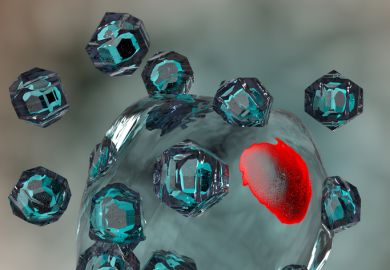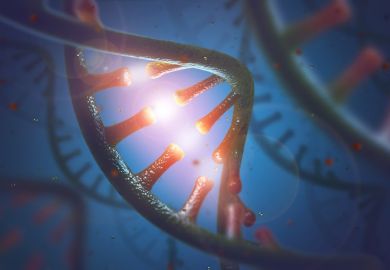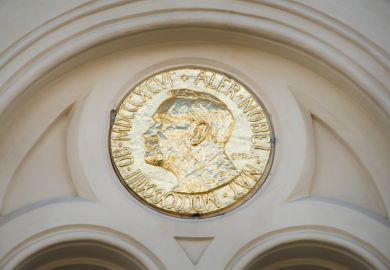Max Perutz focuses on a fellow chemist whose dedication won her a Nobel prize and a saintly reputation.
Dorothy Hodgkin (née Crowfoot) was the third woman to receive the Nobel prize in chemistry - the first and second were the Curies, mother and daughter respectively - and the second woman to be decorated with the Order of Merit -preceded only by Florence Nightingale. She received the Nobel prize in 1964 "for her determination by X-ray techniques of the structures of important biochemical substances". These were cholesterol, medically important as one of the causes of atherosclerosis and for its relationship to several hormones; penicillin; and vitamin B12, the anti-pernicious anaemia factor. No other woman has won the chemistry prize since.
Hodgkin was unique in many other ways. Maggi Hambling, the artist who painted her picture in the National Portrait Gallery, summed her up as "the closest person to a living, walking saint that I have ever met". There was magic about her person, and Georgina Ferry's biography brings her to life through a wealth of letters written by her and those around her.
Tidiness was not one of her strengths (there was a crisis when she had to go to a meeting abroad and had forgotten her passport); and she never discarded any letters, perhaps because she could not be bothered to sort and file them. They proved a treasure-trove to her biographer.
Dorothy Crowfoot was born in Cairo in 1910, the eldest of four sisters. Her father worked in the Egyptian Education Service and was later promoted to become director of education in the British-ruled Sudan. When war broke out in 1914, Mrs Crowfoot took the girls and their English nanny back to England, installed them in a house in Worthing close to her elderly in-laws and left them there, returning to visit them only once during the four years of the war.
Apparently this neglect did Dorothy no harm; nor did it diminish her affection for her parents, but she wrote that it made her independent from an early age.
Mrs Crowfoot was an outstanding woman who later had a decisive influence on Dorothy's development. She had been educated at home and discouraged from studying medicine. To make up for it, she had herself trained as a midwife, a skill that she put to good use after her marriage to help deliver the babies of women in the Sudan. Her stay in Egypt and visits to historic and prehistoric sites in Palestine roused her interest in archaeology and also made her an authority on ancient weaving techniques, interests that she passed on to her daughter. Two of her brothers were killed in the first world war and the other two died from its after-effects, a tragedy that made her resolve to devote herself to the promotion of international understanding. When Dorothy was a teenager, Mrs Crowfoot took her to a discussion on disarmament at the League of Nations in Geneva, an event that made a deep impression on Dorothy and may have been the spur for her later travels round the world as an angel of peace. It finally led Dorothy to accept the presidency of Pugwash, the organisation founded by Albert Einstein and Bertrand Russell to bring together physicists from East and West to halt the nuclear arms race.
On one occasion, Dorothy's parents took her on an archaeological dig in Palestine, where they had made friends among the Arabs. These friendships lasted, and Dorothy made no secret of them when she visited Israel. When I visited the country recently, some colleagues there were still indignant that she should have shown sympathy for their enemies.
In 1826, Michael Faraday instituted the "Christmas Lectures for a Juvenile Audience" at the Royal Institution in London. They have been given every year since and have inspired many young listeners to embark on a scientific career. Dorothy did not attend them, but as a 15-year-old, her mother bought her Sir William Bragg's lectures "On the nature of things" and "Old trades and new knowledge", where he mentioned the discipline of X-ray crystallography, which he and his son had recently introduced. This had allowed them for the first time to "see" atoms. According to Ferry, Bragg's "elegant introductionJI excited the impressionable Dorothy beyond measure". That excitement lasted the rest of her life.
Dorothy's ethereal beauty, soft voice and reticent, gentle manner concealed a razor-sharp mind, a passionate temperament and an iron will to succeed. A fellow undergraduate at Somerville College in Oxford wrote: "She is very quiet and one just has to do all the talking, but anything she says is usually worthwhile. She is an extraordinary person as she is so quiet and yet does all these things. If you can get her to talk she is very interesting too."
This never changed. Dorothy's ambition, enthusiasm and thoroughness often made her work herself sick, but she enjoyed a sound constitution and never broke down. When she was an undergraduate, her parents often left her to look after her younger sisters, but Ferry writes that instead of being distracted from her studies, she learned to cope with having a lot of demands on her time by focusing intensely on each task as it arose and switching her attention rapidly and completely between them. It was a skill that was to prove invaluable in the future. In later years she could switch without effort between mathematical equations and her children's chatter.
After her chemistry studies at Oxford, Dorothy took the first step towards her long-cherished ambition to see atoms by joining the leading young X-ray crystallographer J. D. Bernal at Cambridge. He was a flamboyant Irishman of immense charm and learning, which earned him the nickname Sage. Dorothy fell in love with him, and their relationship lasted until she met her future husband, Thomas Hodgkin. Judging by her letters to Bernal, she was as passionate a lover as she was a scientist. She never saw atoms in Cambridge, because all the crystals prepared by various chemists that Bernal passed on to her had structures far too complex for the methods of X-ray analysis then available, but she joined Bernal in one historic experiment. In 1934, an American physiologist returning from Sweden brought Bernal crystals of the digestive enzyme pepsin, which is a protein. By then biochemists had come to realise that proteins are the engines of the living cell. It was known that they are made up of hundreds or even thousands of atoms, but they were black boxes because the spatial arrangement of these atoms was unknown. It was not even known whether these atoms formed well-ordered structures at all, yet understanding their atomic structure seemed to be the key to the understanding of life itself. Several crystallographers had already taken X-ray diffraction pictures of dried protein crystals, but obtained no diffraction patterns. By keeping them wet, as the protein would have been in the living organism, Bernal and Crowfoot got beautiful X-ray diffraction patterns, which implied that the pepsin molecule had an ordered atomic structure. X-ray crystallography offered a hope of solving it, but fulfilment of that hope was remote because it was hundreds of times more complex than any crystal structure yet solved.
In 1935 Dorothy returned to Oxford to take up a teaching fellowship at Somerville. For her research she was given a table in the X-ray room of the Oxford Museum, Ruskin's neo-Gothic cathedral of science, whose fossil skeletons and general gloom made it look more like a mausoleum of science. But as soon as one entered Dorothy's room, one was lifted into the clouds by her serenity, brilliance and unbounded enthusiasm. One day she was given crystals of insulin, a protein containing fewer atoms then pepsin, which seemed a more hopeful candidate for X-ray analysis. She put a crystal in front of an X-ray beam and placed a photographic plate behind it. That night, when she developed the film, she saw minute, regularly arranged spots forming a diffraction pattern that held out the prospect of solving insulin's structure. Later that night she wandered around the streets of Oxford, madly excited that she might be the first to determine the structure of a protein, but next morning she woke with a start: could she be sure that her crystals really were insulin rather than some trivial salt? She rushed back to the lab before breakfast. A simple spot test on a microscope showed that her crystals took up a stain characteristic of protein, which revived her hopes. She never imagined that it would take her 34 years to solve that complex structure, nor that once solved it really would have medical applications.
Before I read Ferry's biography, I never realised how passionately Dorothy hoped to be the first to solve the structure of a protein, yet in 1959, when John Kendrew and I succeeded, she seemed delighted and never gave us the slightest hint of the disappointment she must have felt.
Much of Ferry's book is devoted to Dorothy's work for disarmament and conciliation between East and West, but this was biased by her unrealistically rosy pictures of the Communist dictatorships in North Vietnam, China and the Soviet bloc. After insulin was solved, she devoted much of her time to these aims; frail though she was and increasingly crippled by rheumatoid arthritis, she became an indefatigable traveller in search of world peace.
Ferry never knew Dorothy Hodgkin, but it seems that the more she learned about her from letters and interviews with her friends and colleagues all over the world, the more she came to love and admire her. Her book is a delight to read, very well documented and refreshingly untainted by feminism (with which Dorothy had little sympathy), relativism or deconstructivism. I learned a lot about Dorothy that I never knew, especially about her youth. Strangers may enjoy it equally.
Max Perutz, OM, was awarded the Nobel prize in chemistry for his work on the structure and function of haemoglobin.
Dorothy Hodgkin: A Life
Author - Georgina Ferry
ISBN - 1 86207 167 5
Publisher - Granta Books
Price - £20.00
Pages - 423
Register to continue
Why register?
- Registration is free and only takes a moment
- Once registered, you can read 3 articles a month
- Sign up for our newsletter
Subscribe
Or subscribe for unlimited access to:
- Unlimited access to news, views, insights & reviews
- Digital editions
- Digital access to THE’s university and college rankings analysis
Already registered or a current subscriber? Login



